

Geoff’s Translations
The GIST
The Blog
“There are inherent uncertainties in the individual response, but at a group level, it should provide a solid base for interpretations” The authors
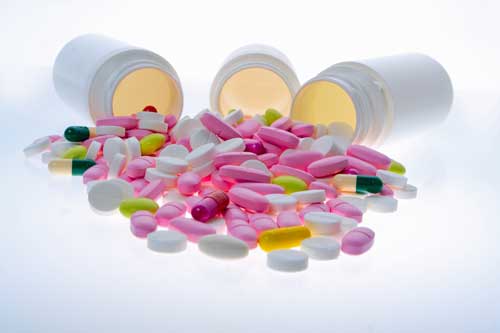
The Open Medicine’s TREATME survey assessed a wide variety of drugs and supplements.
The Open Medicine Foundation said it would focus more on treatments a year or so ago, and it has made good on that promise with the results from its massive TREATME survey. The study, “Patient Reported Treatment Outcomes in ME/CFS and long COVID” – led by Martha Eckey – recently published in none other than the august Proceedings of the National Academy of Sciences (PNAS) journal.
The TREATME survey is the most extensive attempt yet to assess the efficacy of most of the mainstream (and some not-so-mainstream) attempts to get well in people with ME/CFS and long COVID. Almost 4,000 people with ME/CFS and long COVID (split almost equally) answered questions about 150 drug, supplement, and non-pharmacological treatments. Brain retraining programs, brain stimulation, Lorazepam (Ativan), Klonopin (Clonazepam), cannabinoids, diet, and physical therapy were not assessed.
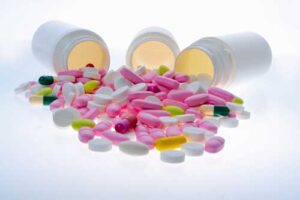
The Open Medicine’s TREATME survey assessed a wide variety of drugs and supplements.
THE GIST
- The results from the Open Medicine Foundation’s massive TREATME survey were recently released. The survey, which covered 150 drug, supplement, and non-pharmacological treatments, was filled out by almost 4,000 ME/CFS and long COVID patients. Brain retraining programs, brain stimulation, sleep drugs, and physical therapy were not assessed.
- The authors produced a figure called “net assessment score” (NAS), which was based on patients’ positive and negative responses to each treatment. Because any level of improvement or worsening is included in NAS, NAS, by itself, does not tell us much about the degree of effectiveness. This led some treatments that did not improve patients much, but were viewed positively by many patients, being included in the top 20 treatments.
- This blog focused more on an appendix, which isolated treatments that “moderately/much better” improved symptoms.
- Twenty-one treatments resulted in moderate to much better improvement over 30% of the time, while 41 other treatments resulted in moderate to much better improvement between 20% and 30% of the time.
- All told, 62 treatments were deemed by greater than 20% of patients to make them “moderately/much better”.
- See the blog for the list of top 21 efficacious treatments.
- IVIG was the big Surprise – IVIG is expensive and hard to get, but of the 91 people who tried it, almost 2/3rds reported moderate to much improvement. The NAS/symptom assessment suggested that IVIG can help fatigue (55.4%), PEM (46.7%), POTS (55.8%), and brain fog (50.8%) frequently (!). Additionally, the NAS graph of the top 20 treatments showed that IVIG was the treatment most often associated with a “much better” response. Check out Martha Eckey’s post on IVIG to learn more.
- Low-dose naltrexone’s high efficacy rate (60% and nearly 1,000 responses) suggests that targeting immune activity in the brain may be highly beneficial. The NAS calculation found LDN improved fatigue or low energy (41.5%), PEM (33.2%), and brain fog (42.3%). (LDN is often used for pain, but pain was not assessed in this study.)
- While being mindful that only 30 people had tried ketamine, its high efficacy (43%) also suggests that brain-targeting drugs may be helpful.
- One big surprise was how few people (20%) have tried pacing, given how often it was efficacious (37%) and how long it’s (supposedly) been a mainstay in managing ME/CFS. (Was this due to fewer long COVID patients embracing it?). According to NAS, pacing was found to help frequently with fatigue (82.7%), PEM (62.6%), brain fog (71.2%), and POTS.
- The good response rates from heparin, triple therapy, and nattokinase/lumbrokinase + serrapeptase suggested that clearing out blood clots can be very helpful. Check out lead researcher Martha Eckey’s post on nattokinase/lumbrokinase + serrapeptase to dig down into these inexpensive supplements’ results, including which brand might work best.
- Ivabradine’s success rate was not surprising given that it appears that it, more than other drugs, is helpful with POTS. The relatively good efficacy for Ivabradine, beta blockers, and propanolol indicates the important role these drugs can play in those with orthostatic intolerance/dysautonomia.
- Only 58 people had tried maraviroc, the drug Bruce Patterson introduced to the field, but the good response rate (41%) suggested he may be onto something.
- Thirty-two treatments were assessed by more than 300 people. In this list, the big losers were the supplements, 17 of which made this list, but which, unless they were paired with something, rarely made the top 62 most efficacious treatments.
- The fact that one type of antihistamine (H1RA) had been tried by about 40% of the patients indicates how far mast cell activation syndrome (MCAS) has penetrated the ME/CFS patient population. (The greatly increased efficacy rate (38%) of the H1RA+H2RA group suggested that patients taking H1RA only might want to add an H2RA antihistamine.)
- It was surprising how few people (20%) have tried pacing, given how often it was efficacious (37%) and how long it’s (supposedly) been a mainstay in managing ME/CFS. (Was this due to fewer long COVID patients embracing it?). According to NAS, pacing was found to help frequently with fatigue (82.7%), PEM (62.6%), brain fog (71.2%), and POTS.
- Many people had tried stimulants (n=457), which had one of the highest response rates (37% moderately-much better), but also produced some significant negative responses.
- MCAS treatments were among the more commonly effective treatments. Of the fifteen treatments assessed, ten were reported by at least 20% of the patients to moderately/much improve their symptoms.
- All of the antiherpesvirus drugs (famciclovir, valganciclovir, valaciclovir, aciclovir) were rated by between 20% and 30% of patients to moderately/much improve their symptoms.
- Except for buproprion (n=172; 30% moderate/much better),the antidepressants did not produce impressive (<20%) results. Two old standbys, Lyrica and gabapentin, both scored fairly well (26% moderate/much better improvement), and low-dose Abilify did well (32% reported moderate/much better improvement)
- None of the gut enhancers or antioxidants produced strong results. The mitochondrial enhancers, in general, did poorly. The big surprise was that only 18% of respondents reported that oxaloacetate produced moderate/much better improvement. If you’re trying CoQ10 or ECCG, higher doses appear to increase efficacy.
- Some of the newer treatments (rapamycin, GLP-1 agonists, plasmapheresis, fecal transplants, stellate ganglion patch, psychedelic drugs) were not assessed. Not many people had tried HBOT (n=37), but almost 30% reported that it moderately/much improved their symptoms. Not many people had tried nicotine patches (n=25) either, and 24% reported that it moderately/much improved their symptoms.
- The study didn’t assess brain retraining, which is open to anyone. The fact that most of the better treatment options involve drugs indicates, though, that this is not a do-it-yourself illness, and that a doctor who is willing to take the time and trouble to trying different approaches is essential.
- Looking to the future, one wonders if the promising showing by immunomodulators (IVIG, maraviroc), brain-impacting drugs (ketamine, guanfacine + NAC), mast cell-impacting drugs, and anticoagulants will play a larger role. Note that several large immunomodulatory drug trials are underway in long COVID.
Health Rising’s Quickie Summer Donation Drive Update
Thanks to everyone who has helped Health Rising reach almost 60% of its goal in its quickie summer drive.
This was a massive study—and it’s a massive blog. This blog turned out as blogs often do – it got bigger and bigger as time went on, and I found more and more to dig into. This blog, which produces lengthy posts that delve into the details of the subject, ultimately focused most of its attention not on the paper’s text but on one of its appendices. If you want that kind of detailed attention we’re the blog for you.
The Study Approach
To encourage more accurate results, patients were asked to review treatments only if they had a good idea of their effects. The participants were asked, “How were your symptoms affected by the following treatments?” and given a series of options from approximately February 2023 to February 2024 (with a 3-month break in the middle).
Five core symptoms (fatigue or low energy, postexertional malaise, POTS, brain fog, unrefreshing sleep) associated with the IOM’s core diagnostic criteria for ME/CFS were included in the primary assessment. (The treatment’s impact on pain was not included.)
- Much better
- Moderately better
- Slightly better
- Unchanged or unsure
- Slightly worse
- Moderately worse
- Much worse
To evaluate the patient-reported effects of treatments, the authors produced a figure called “net assessment score” (NAS) which was based on patients’ positive and negative responses to each treatment. The NAS score for each treatment was then compared to a reference treatment (patient reports for a Vitamin C supplement) and the results were analyzed using a two proportion Z test.
If I’m reading it right, because any level of improvement or worsening is included in NAS, NAS, by itself, does not tell us much about the degree of effectiveness; e.g., NAS does not give a treatment extra points for producing “much better” results. Instead, it tells us which treatments received the most positive and the least negative responses in the most people.
Results
The study found that people with long COVID and ME/CFS were similar symptomatically and responded to the treatments similarly.
The way NAS was produced resulted in treatments like CoQ10, PEA, curcumin, and melatonin, which rarely produced moderate or much better effects but were reported to have positive effects by many people, ending up on the list. Some treatments in this group (IV saline, ivabradine, IgG, heparin (UFH and LMWH), and maraviroc) did, however, produce a significant percentage of moderately/much better results. (See the orange/yellow bars on the left for moderately/much better results).
As the paper pointed out, most of the top 20 treatments with the highest NAS are well known.
Treatments That Moved the Needle
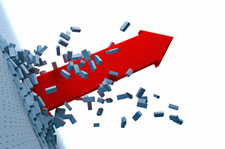
Twenty-one treatments were reported by at least 30% of the patients who tried them to result in moderate to much better improvements.
It was encouraging to see that, of the 150 or so treatments assessed, at least 30% of patients reported some positive effect in 120 of them. I was most interested, though, in treatments that moved the needle; i.e., treatments that were more likely to produce “moderately and much better responses”. These were found in an appendix. (A separate list of “much better responses” was not included for all the treatments. Note that this analysis did not assess the probability statistics.)
The appendix indicated that patients reported that twenty-one treatments resulted in moderate to much better improvement over 30% of the time. It also reported that between 20% and 30% of the time, 41 other treatments resulted in moderate to much better improvement.
All told, 62 treatments were deemed by greater than 20% of patients to make them “moderately/much better”. Plus many more were reported to produce at least moderate effects by 10-20% of the respondents. While patients clearly had searching to do, the study suggested that a wide variety of treatments have the potential to at least moderately improve the symptoms of ME/CFS patients.
- Check out Table 3 in the “Supporting Information”, which lists the responses of all the treatments. Table 3 is found about six or 7 pages down from the top. The column I used (% moderate/much better response) is outlined in blue. The percentage of negative responses is beside it to the right.
The Top 21 Treatments (>30% of patients reported moderate/much better improvement)
- IVIG (64%)
- Low dose naltrexone (60%)
- IV saline (52%)
- Ketamine (43%)
- Ivabradine (44%)
- Maraviroc (41%)
- Ketotifen + H2RA (40%); (Ketotifen w/out H2RA – 29%)
- Enoxaparin or unfractionated heparin (40.1%)
- Guanfacine + NAC (39%…guanfacine w/out NAC – 12%!)
- Cardioselective beta blocker (38%)
- Corticosteroids (37%)
- Pacing (37%)
- Stimulants (35%)
- Triple therapy (anticoagulants) (33%)
- Tollovid > 15 days (36%)
- Mestinon (32%)
- Abilify <2 mg (32%) (Less is generally more with Abilify. Abilify > 2mg dropped to 9%)
- Vedicinals (31%)
- Nattokinase (NK) or Lumbrokinase + serrapeptase (31%)
- Propanolol (31%)
- Buproprion (30%)
Assessment
IVIG – The Big Surprise
IVIG is expensive and hard to get, but of the 91 people who got a hold of it, almost 2/3rds reported moderate to much improvement. The NAS/symptom assessment suggested that IVIG is able to help fatigue (55.4%), PEM (46.7%), POTS (55.8%), and brain fog (50.8%) frequently (!). Additionally, the NAS graph of the top 20 treatments showed that IVIG was easily the treatment most often associated with a “much better” response.
Nothing in the ME/CFS literature made me suspect IVIG’s efficacy would be so high. Both Dr. Ruhoy and Dr. Kaufman, however, like it and Dr. Klimas has said that pooling of IVIG from a large population gives it such a “tremendous advantage” that if an infection is the problem, protection provided by the product can be so complete that you don’t need to know what virus is present – you just need to boost your immune functioning.
- Check out lead researcher Martha Eckey’s take on the surprise IVIG finding here. She noted that it took ten IVIG sessions to produce the result in about a third of patients. A remarkable 80% reported benefits lasting for at least 6 months, with over 50% enjoying benefits for over a year. Discontinuing IVIG, however, resulted in some or all of their symptoms returning. Find out more in her report.
Its high efficacy in this survey may, in part, be due to the doctors who use it knowing which patients it is most likely to help. It suggests that immunomodulators may play a key role in treating ME/CFS over time.
Others
Low-dose naltrexone’s high efficacy rate (60% and nearly 1,000 responses) suggests that targeting immune activity in the brain may be highly beneficial. The NAS calculation found LDN improved fatigue or low energy (41.5%), PEM (33.2%), and brain fog (42.3%). (LDN is often used for pain, but pain was not assessed in this study.)
While being mindful that only 30 people had tried ketamine, its high efficacy (43%) also suggests that brain-targeting drugs may be helpful.
Ivabradine’s success rate was not surprising given that it appears that it, more than other drugs, is helpful with POTS. The relatively good efficacy for Ivabradine, beta blockers, and propanolol indicates what the important role these drugs can play in those with orthostatic intolerance/dysautonomia.
Only 58 people had tried maraviroc, the drug Bruce Patterson introduced to the field, but the good response rate (41%) suggested he may be onto something.
The good response rates from heparin, triple therapy, and nattokinase/lumbrokinase + serrapeptase suggested that clearing out blood clots can be very helpful.
- Check out lead author Martha Eckey’s complete take on nattokinase/lumbrokinase + serrapeptase including brands that might be helpful here.
While supplements did not do well as a group, two drugs suggested that adding them can be very helpful. Adding ketotifen to an H2RA boosted its efficacy dramatically (40-29%). Similarly, adding NAC to guanfacine more than tripled the number of people who reported that it moderately/much better improved their symptoms (39%…guanfacine w/out NAC – 12%!)
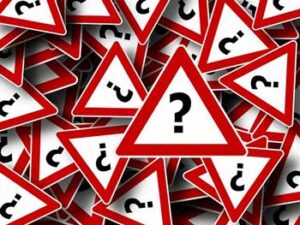
Some of the most commonly tried treatments in ME/CFS did well while others did not.
The Tried (and True?) Treatments
It was interesting to see which treatments had been tried the most. With an average duration of illness of around 13 years, this group has been around long enough to let us know what has worked over time and what kinds of treatments have become widely adopted among patients.
Check out the most tried treatments (n<300) (top to bottom) and the percentage of people who reported they produced moderate-to-much better results for them. Thirty-two treatments were assessed by more than 300 people.
The big losers were supplements, 17 of which made this list, but which, unless they were paired with something, rarely made the top 62 most efficacious treatments. (Note, though, that a compound treatment called Vedicinals, which consists of various mast cell reducers, anti-inflammatory and antioxidant herbs, and natural compounds, did pretty well in long COVID (n=58, 31% moderate/much better improvement).
The Top 32 Most Tried Treatments (in descending order)
- Fluids/electrolytes – n=2860; 26% reported moderate/much better improvement.
- Antihistamines – H1RA (2nd/3rd generation) – n=1474; 22% reported moderate/much better improvement (Check out below to see how combining H1RA+H2RA antihistamines seems to work better (below) than using H1RA antihistamines alone, and how adding ketotifen to H2RAs may work even better (n=48; 40%).
- B-complex – n=961; 8% reported moderate/much better improvement.
- Compression stockings – n=952; 24%. Compression stockings positively help 66% of people but moderately help 24%.
- Low dose naltrexone – n=951; 29%. LDN has been well tried (951 responses) and has one of the highest “moderate to much better” effectiveness.
- Omega-3 complex (DHA + EPA) – n= 818; 7.6%.
- Pacing n=803; 37% reported moderate/much better improvement. Only 803 people reported that they’ve tried pacing yet pacing’s 37% “moderate to much better effect” on symptoms suggested it’s one of the most effective things to do.
- B-12 injection – n=760; 20% reported moderate/much better improvement. B-12 injections may be the oldest treatment on this list – and at 20% of people reporting that it produced moderate to much better effectiveness, it’s still hanging in there.
- SSRI antidepressants (minus fluvoxamine) – n=731; 16% reported moderate/much better improvement. The different kinds of antidepressants all clocked at about 15-20% (moderate to much better effectiveness) except for Bupropion (n=172; 30%)
- Aspirin n= 636; 11% reported moderate/much better improvement..
- Omega-3-6 or Omega 3-6 9 – n=573; 6.3% reported moderate/much better improvement.
Coenzyme Q10 – many people have tried CoQ10, and more does indeed seem to be better, although the percentage of people reporting moderate to significant improvements even at the highest dose was relatively small (14%).
- Coenzyme Q10 – 100 to 200 mg/day – n=566, 6%.
- Coenzyme Q10 – 50-100 mg/day – n=382; 8%.
- Coenzyme Q10 – >200 mg/day – n=377; 14%.
NAC – as with CoQ10 ,notice the jump in NAC’s effectiveness at the higher doses. (NAC ≤600 mg/day 562; 8% reported moderate/much better improvement; NAC >600 mg/day n=352; 20% reported moderate/much better improvement. Also that while guanfacine + NAC has been less tried, adding NAC to guanfacine appeared to boost its effectiveness dramatically.
- H2RA (Famotidine) – n=551; 21% reported moderate/much better improvement.
- D-ribose – n=548; 10% reported moderate/much better improvement. D-ribose was a big hit a decade or two ago, but according to this survey, it has not stood the test of time.
- Amytriptyline and other TCA antidepressants – n=529; 15% reported moderate/much better improvement.
- Green tea/Matcha/EGCG – n=485; 4% reported moderate/much better improvement.
- Curcumin – n=480; 11% reported moderate/much better improvement.
- Nattokinase/Lumbrokinase – n=475; 27% reported moderate/much better improvement.
- Nattokinase/Lumbrokinase + serrapeptase – n= 430; 30% reported moderate/much better improvement. These are anti-clotting supplements, and with a 27% moderate to much better improvement rate, they were one of the most effective supplements.
- Beta blockers or Ivabradine – n=458; 38% reported moderate/much better improvement.
- Quercetin – n=422; 13.3% reported moderate/much better improvement.
- SNRIs – n=407; 21%reported moderate/much better improvement.
- Melatonin 1-3mg; n=407;16% reported moderate/much better improvement.
- Stimulants (Vyvanse, Adderall, Ritalin, Focalin, Dexedrine, others) – n=427; 35% reported moderate/much better improvement. The survey suggests that, while they can have more negative side effects, stimulants are more effective at enhancing energy than mitochondrial supplements.
- Antihistamines – H1RA + H2RA (combo) – n=352 – 38%. Among all the MCAS medications, combining H1RA (diphenhydramine, hydroxyzine, etc.) and H2RA (Cetirizine, fexofenadine, loratadine, etc.) antihistamines were the most effective.
- Vitamin C (oral, liposomal) – n=330; 8% reported moderate/much better improvement..
Assessment
The fact that fluid/electrolytes and compression stockings rank high on the list indicates that, at least in this (knowledgeable) patient population, the word on POTS/orthostatic intolerance has been received.
Similarly, the fact that one type of antihistamine (H1RA) had been tried by about 40% of the patients indicates how far mast cell activation syndrome (MCAS) has penetrated the ME/CFS patient population. (The greatly increased efficacy rate (38%) of the H1RA+H2RA group suggested that patients taking H1RA only might want to add an H2RA antihistamine.)
The big surprise for me was how few people (20%) have tried pacing, given how often it was efficacious (37%) and how long it’s (supposedly) been a mainstay in managing ME/CFS. (Was this due to fewer long COVID patients embracing it?). According to NAS, pacing was found to help frequently with fatigue (82.7%), PEM (62.6%), brain fog (71.2%), and POTS.
The word has clearly gotten out about blood clots. I was surprised by how many people (mostly long COVID patients?) had tried nattokinase/lumbrokinase (475) and impressed by the relatively good response rate (w/+ serrapeptase 30%). (Note that by itself, serrapeptase had a low moderate/much better response rate (11%).
I was also surprised that so many people had tried stimulants (n=457), which had one of the highest response rates (37% moderately-much better), but also produced some significant negative responses.
Types of Treatments
MCAS Treatments
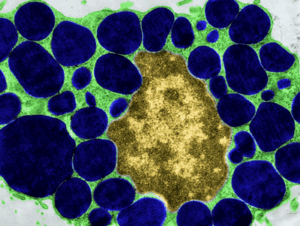
Mast cell inhibitors, in general, seemed to do better when combined together.
MCAS treatments were among the more commonly effective treatments. Of the 15 MCAS treatments assessed, only two were rated as moderate/much better by less than 10% of patients, four by between 10% and 20% of patients, and eight by between 20% and 30% of patients. Two were reported by over 30% of patients (ketotifen + H2RA (40%) and H1RA + H2RA (combo) (38%)) to moderately/much improve their symptoms.
Antivirals/antibacterials
All of the antiherpesvirus drugs (famciclovir, valganciclovir, valaciclovir, aciclovir) were rated by between 20% and 30% of patients to moderately/much improve their symptoms.
Of the antibiotics, doxycycline (<50 mg; > 100 mg) was rated by between 20-30% of patients to moderately/much improve their symptoms. Patients should stay away from sulfamethoxazole drugs which had low efficacy and high rates of side effects.
Neuropsychiatric drugs
Except for bupropion (n=172; 30% moderate/much better), with less than 20% of patients reporting significant improvement, SNRIs (Cymbalta, Savella) or SSRIs (Paxil, Zoloft, Lexapro, Prozac) antidepressants produced impressive results. Two old standbys, Lyrica and gabapentin, both scored fairly well (26% moderate/much better improvement). Low-dose Abilify (32%) also appears here to stay and shows how one doctor (Dr. Hector Bonilla at Stanford) can make an impact. Twenty to thirty percent of respondents reported, though, that several of these drugs produced negative effects.
Blood Clot Removers
With three anti-clotting treatments in the top 21 (heparin, triple therapy, nattokinase/lumbrokinase + serrapeptase) the blood clot removers did well.
Lead author, Martha Eckey, reported that nattokinase/lumbrokinase + serrapeptase worked better in long COVID than ME/CFS, but still was often helpful in ME/CFS. The symptoms most commonly improved included fatigue (56%), brain fog (55%), memory problems (47%), feeling of weakness (46.5%), PEM (46%), shortness of breath (40%), chest pain (36.5%), and fast/fluttering/pounding heart (33%). Most people (3/4) knew whether the supplement was working or not within two weeks. Note that nattokinase/lumbrokinase + serrapeptase is not an expensive supplement. More (8,000 FU) was better, and Eckey found that Solaray’s NK-SP seemed to work best. Check out her report here.
Gut enhancers
None of the gut enhancers (colostrum, lactoferrin, various kinds of probiotics, butyrate) were reported by more than 20% of patients to moderately/much improve their symptoms.
Mitochondrial Enhancers – go high with them (if you go at all)
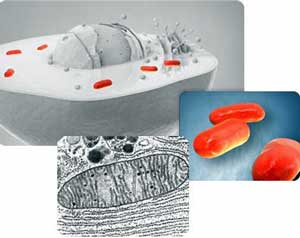
While the mitochondrial enhancers had middling results, several times it appeared that more was better when it came to them.
In general the mitochondrial enhancers surveyed did not do well. Most surprising (and disappointing) was the fact that only 18% of the 77 responders reported that oxaloacetate made them moderately or much better. (Did they not take enough of it?). Over 500 people tried D-ribose, but only 10% reported that this formerly very popular supplement made them moderately or mostly better.
In general, the survey suggested that if you’re going to try a mitochondrial supplement, go high (ECCG <400 mg = 7%; >400 mg 20%; CoQ 10 <50 mg/day – 8%; 50-100 mg/day – 8%; 100-200 mg/day – 6%; >200 mg/day 14%). CoQ10 has been well-tried with hundreds of people providing responses for each dose.
Mitoquinol, a form of CoQ10, on the other hand, did better with 22% of the 49 responders reporting it moderately/much better improved their symptoms.
Creatine .- the subject of a recent blog – was which did well in a couple of small studies, was not assessed.
If you want to up your energy, though, stimulants might be a riskier but more promising avenue
Vasodilators
Few patients (10-16%) reported moderate to much better improvements using vasodilators such as Sildenafil, L-arginine, and/or citrulline.
Antioxidants
Despite clear evidence that reactive oxygen species are increased in ME/CFS, the antioxidants did not fare well.Only about 10% reported moderate to much better improvement with oral or liposomal glutathione, and alpha-lipoic acid, with its 5% significant response rate, was similarly disappointing.
The Newbies
Some of the newer treatments (rapamycin, GLP-1 agonists, plasmapheresis, fecal transplants, stellate ganglion patch, psychedelic drugs) were not assessed.
Hyperbaric oxygen therapy (HBOT) was, though. Not many people had tried HBOT (n=37), but almost 30% reported that it moderately/much improved their symptoms. Not many people had tried nicotine patches (n=25) either, and 24% reported it moderately/much improved their symptoms.
The Disappointments

Supplements, gut enhancers, vagus nerve stimulation, and metformin mostly appeared to miss the target.
With the acknowledgement that the vagus nerve stimulation field is still emerging and significant questions remain about dosing and the type of machine to use, it was still disappointing to find that only 14% of the 132 people reported receiving moderately to much better results from it.
Despite the fact that butyrate levels are low, butyrate-producing probiotics (n=27) did not fare well (7%) (but had not been tried much). Metformin has been much discussed, and 140 people had tried it, but only 14% reported that it moderately/much improved their symptoms.
Symptom Trends
When it came to which of the top 20 treatments produced the best outcomes for specific symptoms according to the NAS calculation, some interesting trends emerged. NAS – which measures positive results but does not assess higher degrees of efficacy – suggested that if you want to treat:
- Fatigue – pacing (83%), stimulants (72%), IVIG (55%), nattokinase/Lumbrokinase (50%), manual lymphatic drainage (45%)
- PEM – pacing (63%), IVIG (47%) – not many treatments for PEM.
- Brain fog – stimulants (77%), pacing (71%), Mestinon (57%), IVIG (56%), nattokinase/lumbrokinase (50%), low dose naltrexone (42%), PEA (35%), Rx anticoagulants and/or Rx antiplatelets (35%), Vit B12 (33%).
- POTS – Fluids/electrolytes (72%), beta blockers/Ivabradine (66%), compression stockings (64%), mestinon (57%), IVIG (56%)….many treatments for POTS.
- Brain fog – ADHD stimulants (77%!), pacing (71%), IVIG (51%), nattokinase/Lumbrokinase (50%).
- Unrefreshing sleep – melatonin (34%) – the survey did not assess many sleep drugs.
Overview
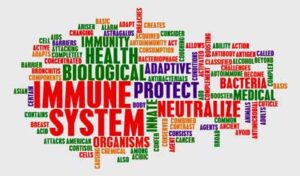
IVIG and Maraviroc’s success suggests that immunomodulators may ending up being key. Several are in long COVID clinical trials.
This is the most extensive survey of treatment results for ME/CFS and long COVID we’re likely to see for quite a while.
How happy you are with the results may depend on how deeply you want to dig. A 20% response rate (moderate/much better) indicates that for every five people who tried a treatment, one received at least a moderate effect, suggesting that extensive investigation is required. On the other hand, the fact that 62 treatments had a one in five chance of producing moderate results means plenty of options do exist.
The study didn’t assess brain retraining, which is open to anyone and has produced the majority of recovery stories on the internet. The fact that most of the better treatment options assessed in this survey involve drugs suggests that a doctor willing to take the time and trouble to try those approaches is essential.
Looking to the future, one wonders if the promising showing by immunomodulators (IVIG, maraviroc), brain-impacting drugs (ketamine, guanfacine + NAC), mast cell-impacting drugs, and anticoagulants will play a larger role. With IVIG and maraviroc, producing relatively high percentages of patients who reported feeling “much better” and with few side effects reported, immunomodulatory drugs may be the drugs of the future. Note that several large studies are currently assessing IVIG, maraviroc, and other immunomodulators in long-standing COVD.
Ketamine’s ability to increase neuroplasticity suggests that psychedelic drugs (currently being assessed) might be helpful, and makes one wonder again about the focused ultrasound machine Jarred Younger is testing. Given their decent showing, one has to wonder what improved antivirals might do.
Supplements pretty much bombed – unless they were paired with drugs, in which case a few proved helpful, indeed. Despite the obvious gut dysregulation, the short list of gut enhancers assessed did not appear to move the needle much.
The poor showing by most of the mitochondrial enhancers suggested, as several recent papers suggest, that there’s either more to ME/CFS than mitochondrial disruption (or that the wrong treatments were tried). It’s too bad, though, that rapamycin did not make the list.
The study, which began in 2023 and 2024, highlighted the rapid evolution of treatment options as a range of new therapies (rapamycin, GLP-1 agonists, plasmapheresis, fecal transplants, and psychedelic drugs) emerged, many of which had not been previously assessed.
Let’s hope the Open Medicine Foundation makes these surveys a regular occurrence. Lastly, check out lead researcher Martha Eckey’s substack for more information on the survey and long COVID treatments.
Health Rising’s Quick Summer Drive Update

What are the most effective treatments for ME/CFS and long COVID? We dug into the appendices to try and find out.
Thanks to everyone who has helped Health Rising reach 56% of its goal in its quickie summer drive.
This was a massive study—and it’s a massive blog. This blog turned out as blogs often do – it got bigger and bigger as time went on, and I found more and more to dig into. This blog, which produces lengthy posts that delve into the details of the subject, ultimately focused most of its attention not on the paper’s text but on one of its appendices. If you want that kind of detailed attention we’re the blog for you.
Please Support Health Rising and Keep the Information Flowing
HEALTH RISING IS NOT A 501 (c) 3 NON-PROFIT


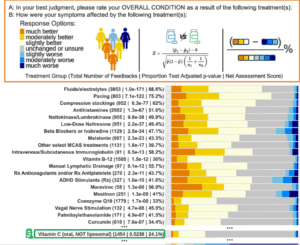

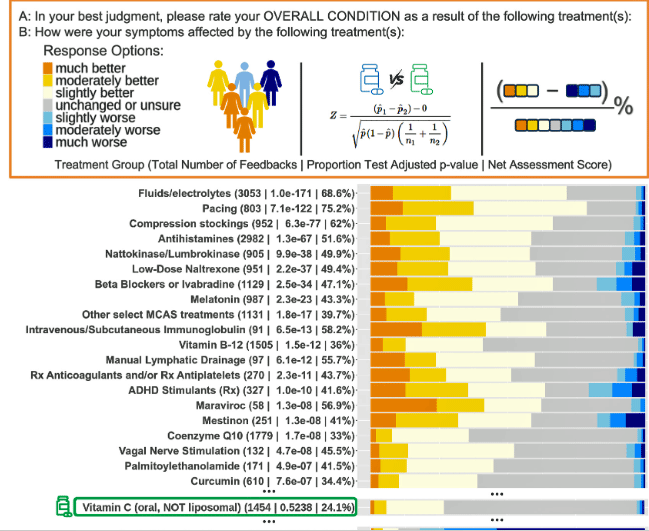

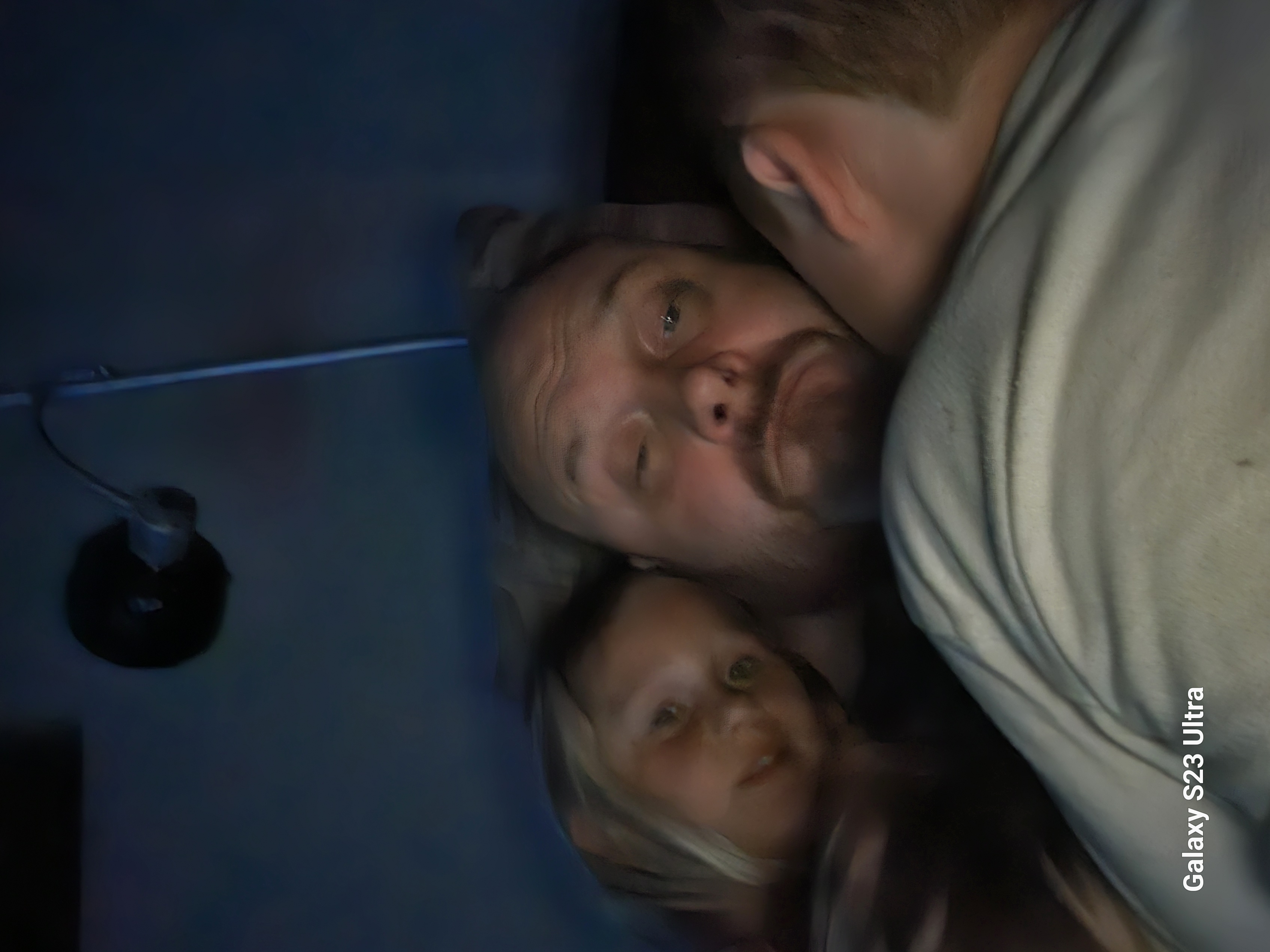

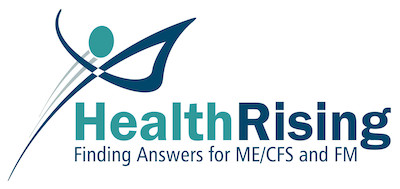
I must say, I am surprised very high dose vitamin B1 was not on the list (unless I missed it), given Jeffrey Lubell’s survey results which you reported on. Something like 2/3 of respondents benefited significantly. It is the most helpful treatment I personally have tried.
👍 definitely
Actually, thiamine was assessed and they assessed it quite well (you have to go to the supplemental data – https://www.healthrising.org/wp-content/uploads/2025/07/Appendices_.Marked_Up.sapp_.pdf ) to find it, though.
With B1 more was better.
Thiamine < 100 mg = 11% said it moderately/much better improved their symptoms Thiamine >100 mg = 19% said it moderately/much better improved their symptoms
Thiamine – dose unknow – 5% said it moderately/much better improved their symptoms
Thanks Cort. I ramped up slowly and only noticed any effect at 600mg/day. Now I take 1g/day with a very significant improvement. I owe it to your posting of Jeffrey’s survey! I took the chance of being the first commenter to evangelize a bit. As far as I am concerned (severe ME/CFS), thiamine is the real deal!
A case where more is indeed much better! This is the kind of fine-tuned stuff that I wish we had more of. I wonder how often we’re just off on the dose (???). Thanks for the reminder to try it at higher levels.
I agree Cort. I’ve tried a lot of supplements that seemed to help at first but diminished greatly later. I tended to think it was just the giant CFS mystery, but now I wonder if it was a dosage problem. It’s also expensive trying so many things.
I am taking thiamine at 400mg 2 times a day and I believe it made my relapses milder and farther apart. 100mg didn’t do anything noticeable.
Just in case you are interested in why it works for some people, myself included. https://www.eonutrition.co.uk/post/mega-dose-thiamine-beyond-addr
Any side effects with that high of a dose? I noticed you said to go up slowly, just wondering how slowly.
Hello Deborah – Starting from 100mg/ day I increased by 100 mg every few days and remember losing hope at 300 mg when there was no effect. In fact I was overall doubtful that I would be one of the (large) subset for whom it would work — nothing else had — except NAC a bit. However there was a distinct effect at 600mg, which seemed to wear off after a couple of weeks. Each time I increased the dose — very repeatably — I would see a similar improvement, which would wear off again. The main thing was (is) a lessening of the dreadful poisoned feeling in my brain and I am not aware of any side-effects. I continued to 2g per day over months, but then thought it was not doing anything and stopped for months. My latest trial in the last 6 months has been at 2 X 500 mg and there has been a permanent improvement. What am am finding, that is greatly encouraging, is that bouts of PEM are shorter and less severe than they were. This means that I have, by “training” been able to increase my tolerance of exertion significantly. This would have been impossible without the B1 since the PEM from inevitably over-doing it would have wiped me out for so long that no improvement in conditioning would have been possible. At the time of writing, this steady improvement has been interrupted by contracting Lyme disease, so I have to recover from this before continuing the B1 experiment. I do think researchers should study the effect of B1 in an effort to understand the mechanisms of ME/CFS.
Thank you so much for your reply. I will start there and see how it goes. I was just lost on what to do next when I came across a study about thiamine and it gave me hope. I really appreciate your detailed information.
Again, thank you so much 🙏🌿
Came here to look for thiamine specifically.
I’m the best I’ve been in 8 years, thanks to thiamine. I’m pretty sure I’ll even be able to exercise regularly again. Haven’t gotten around to specific testing for exercise, but I did spend 40 hours on my feet in one week, doing a project that would have taken 2-3 months of very small bursts, pre-thiamine. Quite a bit of strenuous activity and the only payback was what you’d expect from a body exerting itself after being sedentary for 10 years.
Cognition is faster, more flexible and better at staying on track, memory improved etc.
Need a bit more testing and slow ramping of physical output, but I’m feeling like I have probably gotten my old life back.
It helped me! It takes high doses, 300-600mg in one dose to overcome the enzyme block. Here are the details in case you haven’t seen it. https://www.eonutrition.co.uk/post/mega-dose-thiamine-beyond-addr
Soory that link is not working. Could you please send the headline of the research. Thank you.
Sorry. Mega-Dose Thiamine: Beyond Addressing “Deficiency” https://www.eonutrition.co.uk/post/mega-dose-thiamine-beyond-addressing-deficiency
I agree. I am getting beneficial effects from a combination of thiamine and benfotiamine. 500 mg / day
Just an FYI. Benfotiamine didn’t keep me at all even in large doses. Then I read that it doesn’t cross the blood-brain barrier so switched to thiamine. In 3 days my CFS fatigue was gone.
I am combining thiamine and benfo. I actually take the benfotiamine to help with pain. Sulbutiamine is the one which is lipophilic and crosses the bbb more easily than thiamine. I’ve tried it before and it increased energy. But plain old thiamine seems to work too.
Thanks, I’ll check that out! 🙂
Just want to point out that this survey didn’t originate with the OMF. It was the lead author’s (Martha Eckey @organichemusic) initiative. I assume she went to OMF to get help with analysis and writing it up.
There’s some detail on her initial analyses on her substack:
https://pharmd.substack.com/
Thanks! I missed her analysis! I am incorporating some of it in the blog.
Right! Martha Eckey, PharmD, is an extraordinary person. She persevered through thick and thin to be the sole creator of her deeply detailed survey, then she disseminate it far and wide and then she analyzed the results on many different levels. It was wonderful that she next teamed up with OMF and Wenzhong Xiao, PhD, and others to bring it to the conclusion of this very helpful paper. Thank to this team for bringing us this important information.
My experience with Maraviroc. My physician agreed to let me try Maraviroc at half doses (because of my sensitivity to chemicals) for six weeks. We decided to wait to see if adding a statin would enhance the effectiveness.
Maraviroc made me slightly dizzy and tired. I also gained three pounds of what I assume was water weight in a week to the point where I couldn’t button my jeans. I also developed an ear infection during this week. (Edema and ear infections have been reported as side effects of Maraviroc.)
When I researched the potential side effects of Maraviroc I found these and many more serious possibilities, especially regarding the liver.
Since I had not seen any improvement in symptoms and considering the new University of Edinburgh research listing blood markers for liver disease in their large study of 1455 ME/CFS patients, I decided to stop taking the drug.
Maraviroc may work great for patients without chemical sensitivity, but if you have this, I would be very cautious about trying this drug. In fact, I would wait for more published data on this protocol. I had been feeling worse and was anxious for some boost in health, but Maraviroc wasn’t it.
The chart in this blog didn’t mention clonazepam or Nexavir which were treatments Dr. Cheney found the most helpful in his patients over the years. These treatments and B-12 shots helped me the most over time.
There are some Gulf War researchers who believe that pyridostigmine (mestinon) can trigger ME/CFS so I have never understood using it is a treatment.
Thanks for this detailed report on the survey findings. I was most surprised at the low number of respondents who had tried pacing. Of all the interventions I’ve seen recommended by various healthcare agencies, pacing has always been at or near the top of the list. But many people lack access to doctors, and many doctors lack training about ME/CFS. So it goes.
Pacing doesn’t appear to resolve CFS it just keeps the PEM from crashing your system. It’s part of the plan to get better but definitely not the single cure.
That’s right.
It’s quite interesting to have such overview at our disposal, for both patients and doctors seeking to evaluate treatment options. The full color bars give a good estimate of the chance of success versus the chances of it ending badly, be it temporarily or very hard to recover from.
What I noticed is that you (Cort) cut off the graph excluding the last treatment option: GET. That line states:
Graded Exercise Theraphy (299 | 1.0000 | -72.2%)
In plain words: that says 299 patients responded they had Graded Exercise Theraphy, there is a P chance of 1.0000 for the outcome or a 100.00% (yes, those decimals are correct before rounding) chance for GET *on average* to yield worse (as measured by patient reported experience) patient health and a score of -72.2% indicating much more patients got worse then better.
Actually, there is only ONE theraphy that gets as high as score in absolute value but positive, and that is Pacing, at a score of +75.2%.
Combined: both extremes (-72.2% and +75.2%) say that one theraphy has, on average, far more NEGATIVE then positive outcomes, the other on average far more positive then negative outcomes.
Curiously, some “research” was able to combine both in a single “research study” by hijacking the common name for it. The “study” was called “PACE”, and found GET to be very effective / curative and found that patients doing less made themselve ill by avoiding exercise out of an irrational fear (patients would call this method pacing).
To call pacing (on average!) as safe and effective as GET isn’t safe nor effective (on average!) based on these numbers would even be a big stretch too far. The typical amount of improvement for pacing is much less outspoken then the typical amount of getting worse (both as reported by patients’ experience) with GET: An overwhelmingly 50% reports to be MUCH WORSE after GET versus (hard to read on the graph) while only a paltry 1 to 2% reports to be much better.
=> from analyzing patients’ reporting included in this study, as done by the authors, GET can be called the exact opposite of a “piece of safe and benign theraphy”. Granted, patients reporting isn’t a double blind study. But the PACE “study” did have a lot of objective criteria in its design and ditched them all but one halfway the study to depend nearly completely on patient reporting too.
=> I feel this is essential information for both existing patients still having to shake of the guild from chosing to pace, for new patients being unaware of the average and very often extreme outcomes of GET (while it stil is at times recommended as a safe must do theraphy even up to today by health care and insurrance professionals) and health care professionals chosing to guide and help patients.
=> Any reason why this piece of information did not make it to the blog? To not stir up controversy?
I could imagine that choise. The paper just shows it in the graph and never mentions it either. I imagine that stirring up controversy was expected and chosen to be avoided by the authors. As a victim of PACE-type “research” and “theraphy” myself, I do however find good information on how things can have negative outcomes up to permanent devastating ones is as valluable or even more then emphasing what helps some. At ten years and counting, I am fighting with very much effort and dedication (plus quite an amount of skill, knowledge and plenty of plain luck) against the train wreck / “my year of hell on Earth” that followed in the wake of that “safe and benign piece of GET / CBT”.
It took me finding ways to try as safe and possible many of the positive things in the paper, learn to better evaluate outcomes, finding optimal doses and decision points to revert course PLUS quite a number of things not in that graph yet and I still am barely as “good” as I was before that round of GET / CBT. Therefore I say that even that one line is as important and valuable as the rest of the lines in that graph above it. Having the full table in that graph would be even better. I do understand the risk of the authors publishing that, but I hope one day that will become a reality.
As conventional healthcare says: it is far better and more effective to prevent then to have to cure. Having and showing the table with negative to deeply negative outcomes is of great value here.
I didn’t “cut off” the graded exercise therapy portion of the graph. If you look you can see that it was separated from the rest of the graph – and I could not fit it into the image when I copied it. That’s why its not there. Thanks for providing the information on it.
I just added the image separately into the blog.
My apologies Cort. I first half read your blog, then read the paper. I saw the graph in the paper and scanned it for any word on it and failed to find it in the analysis or discussion. Maybe I didn’t search well enough, but it is a rather sore point to me.
Before that round of CBT / GET that was so strongly claimed to be safe and effective (I would have settled for safe all on its own) I already had ME/CFS plus FM, yet still couldn’t understand why some studies called it one of the worst conditions to live with well before many other bad conditions. That “theraphy” made me very well and intimately acquainted with the depths and desparation of bad ME/CFS. At worst it is for people suffering it purified agony without reprieve, and now I know too. Just getting through even a single of a series of bad days was a mental challenge beyond words or comprehension to those who never experienced it. Even now I can no longer grasp the true depths of that agony thanks to getting a measure of health and life back.
Trying to halt the further gradual decline from even those depths back then and fighting bit by bit my way back was a challenge unlike anything I ever experienced in my life and never ever hope to experience again.
So I admit I was blind to what was below the end of that graph and scanned the text for any words on it, in a mental tunnel formed by the very pain this CBT /GET thing brought in and wrecked my life as it did with so many others.
From my experience and the experience of many others I heared and read about, it looks like the damage of this one “piece of benigne and safe theraphy” has caused more damage then all the good the theraphies on top of it combined have done for hordes of patients. And while those other theraphies can require taking risk for temporary or permanent setback, costing energy and effort we can’t muster or money we don’t have, avoiding the negatives of this CBT / GET combo requires no effort of us at all but rather the opposite: not doing the effort to further ruin our health. All we need is more information and studies making the very risk more clear and scientifically quantified.
In this case: we have a P equal to 100.00% that on average the outcomes of GET are negative. This paper / study even uses close to the same methodology as the PACE “study” does: mainly relying on patients’ self grading their symptoms before and after the GET “theraphy”. Remarkable how different the outcomes are given the modest differences in study protocol isn’t it?
So, sorry again Cort. I got blinded by spotting a very sore point for me.
No worries at all and thanks for explaining about your experience. I remember that it was very bad.
Anyone who has had the PACE trial quoted to them at a medical appointment knows the righteous indignation that comes with the dangerous vacuum left by the ignominy that study has not yet garnered among relevant audiences.
Glad the info is there.
A note on d-ribose: I was lucky enough to be evaluated by a competent metabolism specialist (Dr Julian Ambrus, previously highlighted in a HealthRising blog) and was diagnosed with myoadenylate deaminase deficiency… among other things. Dr Ambrus recommended d-ribose for that condition and it basically allows me to live independently where otherwise I don’t think I could. I still have pretty significant “ME/CFS”. The deficiency is found in a small subset of the population and is exacerbated by infections/etc.
it’s worth trying as it is cheap and essentially side effect free and could change the lives of some individuals. However it makes sense that it’s not more widely effective.
Also I have to shout out creatine. Super helpful!!! I can’t believe more people don’t use it.
I also have MTHFR issues and methyl-folate and adenosylcobalamin (B12) are helpful for that.
At the end of the day, Dr Ambrus believes we each have a metabolism that is somehow messed up. The treatment for each situation depends on what is messed up. So it’s worth trying even the less well received from the list, if you can’t find relief elsewhere
Thank u , Ryan, for ur tips.
May I ask is the test for myoadenylate deaminase, covered by medicare or any insurance.? Thx Wendy
Hi Wendy,
The test was covered by my insurance at the time – BlueCross/BlueShield.
I’m not sure if this is a widely available test or not. I was lucky to live close to an actual expert!
On this particular diagnosis though it may just be better to try d-ribose. Esp. If you can’t get the test for one reason or another. I say this because the only treatment is to take d-ribose, which is cheap and available OTC. If you take it for 6 weeks, you’ll either see an improvement or not. It was suggested that I take 4grams 4 times per day (16 g / day). It can lower blood sugar so I suggest to take with food or beverage.
Here is a full list of what Dr Ambrus suggested for me, for what it is worth:
D-ribose
Creatine
NAC (1800 mg / day)
Methyl-folate
L-glutamine
CoQ10
Alpha lipoic acid
Carnitine
Vit-C
Vit-E
Thank you, rysn, for ur thoroughness. Dr ambrus is in new york, right. I have been taking d-ribose but I don’t think I’ve been taking enough. Thank you for the witness that it works for u. I will continue spending my money on it.
Bless u for ur support with our challenging condition.
It is good to know we’re not alone in this.
Ryan, may I ask what brand methy-folate? ( I get confused, some ( otc) have that “five dash ” in front of methylate…… some have an ” L “before the methyl-folate ). Thx!
Sure – I use Jarrow Formulas “Methyl Folate” 400 mcg. 2 x per day
The active ingredient is 6(S)-5-methyltetrahydrofolate
We saw that mitochondrial supplements taken in combination with guanfacine, for instance, can be very helpful and that more, in general was better. I wonder the study just didn’t capture how helpful they can be taken in combination with each other and other treatments.
Any you are right! I think 62 drugs and supplements were found to be moderately/very helpful by 20% of patients and many more by 10-20% of the patients.
And a big “Thank You”, Cort. I would not have found Dr Ambrus without this blog and also the content is always interesting and informative. Appreciate you!!
Why did you cut off the extremely harmful “Graded Exercise Therapy” segment? See original post here: https://pharmd.substack.com/p/preprint-release-and-supplementary. Also, please stop (everyone) saying that pacing is “treatment” of anything. It’s a method of trying to avoid worsening symptoms while we’re waiting for real research. If that allows the body to heal a bit, that’s great. But to claim it as a valid treatment lets medical establishment off the hook for decades of neglect and mistreatment, in the literal origins of that word. It’s really only saying not to cause damage by overexertion while have nothing else by standard research due to decades of misconduct by mouthpieces spreading misinformation. Words matter. Don’t start statements with repeating their misinformation. Start always with correct information.
As I noted, GET was at the bottom of the graph and separated from it and it simply didn’t fit into the image I copied. (I just included it). I didn’t cover graded exercise therapy in general because it’s so clear to this community that it doesn’t work (we’ve been covering it for decades now) that I thought it wasn’t necessary.
Pacing was included in the treatment category because that was the category the authors put it in.
The misinformation I was referring to was being spread by the PACE cabal. And when I said please don’t repeat misinformation (from them), as I mentioned, it was a general plea to anyone writing about this topic. Example, not leading with “Chronic Fatigue” or “not all in your head” ( of course, it’s not) etc… again, it was a general comment to anyone writing about it anywhere. Separately, in your case, I do find it odd that you cut off just one item from the list and now you’re saying it’s because it’s been discussed here before. I think all of those things have been discussed here before, but it’s a new context which is why you wrote about it, right? It’s your blog and your choice.I was just asking the question. That’s all. It felt important to show how extremely harmful it had been to so many people since this is a source of information about treatment results.
Thanks, P – but please note that I did not cut the GET line off from the image. It was separated from the rest of the image, and when I copy an image, there are times I just can’t fit all of it into the copy.
As I said, thanks to yours and DeJurgen’s comments, I went back in, copied it separately, and added it to the blog.
Oh, then I wasn’t mistaken it wasn’t in the original blog. Yes, I understand the (probably) screen grab problem. Been there, done that :-).
I think what P is trying to say just as I do that there are four opportunities here:
A) Having a repeat from time to time how devastating bad treaments can be, as a way to tell people (patients, doctors, care-givers) who only recently started to read up on the topic. They are often new to ME/CFS, and those are the people that are still vulnerable to this piece of @#§$ theraphy still pushed by more then a few professionals.
B) Understanding that the methodology of this paper is in essence not that much different from the methodology (after they halfway the study ditched near all objective outcomes) from the PACE trial.
C) Understanding what a P = 1.0000 means: it is statistically extremely unlikely that the outcome is not negative. Actually the P for the average outcome for GET being negative according to the methodology use in the paper would be P < 0.0001 which is a very strong statistical indicator the hypothesis (outcome of GET is getting worse) is correct.
D) It takes a lot of "courage" for any scientist to claim the outcome of PACE is not obliterated (P < 0.0001 in study with fairly similar methodology) or at least very much under scrunity given point C).
I’ve noted a big improvement with enbrel and metformine;) a little less brain fog and maybe more energy.
I suspect that the reason for the low numbers of oxaloacetate is the cost for anyone to actually take the amount that previous study showed helpful.
I also suspect that the reason supplements paired so poorly, esp mitochondrial enhancers is that they need to be taken in combination &/or higher doses. There are so many things that impact mitochondrial function that taking one or two supplements for it, but leavign out other vital ones would prevent the ones being taken from working. FWIW, I am one for whom they have helped some, esp D Ribose, though my overall ME has worsened over the 21 yrs I’ve been sick. However, there are a lot of other reasons for that. Re D-ribose, I still notice a big difference when I take it, even though “big” is very relative, given how sick I am.
I have a lot more thoughts about this, but that’s all I can handle writing rt now.
oops that was supposed to say supplements fared so poorly, not paired….also while I only really explained re mito supps, what I said could hold true for a lot of other supps as well
“supplements paired so poorly, esp mitochondrial enhancers is that they need to be taken in combination &/or higher doses.”
I would not be surprised. I’ve been planning to take a bunch of them together and see what happens.
I hope it helps you
Oxaloacetate was a game changer for me, along with low-dose Abilify. But I take 2g per day, which can be cost-prohibitive for some. I learned how to “roll my own” using a recipe provided by GROK. It’s simple chemistry — malic acid, hydrogen peroxide, some ferrous sulfate…I can send the instructions if anyone is interested.
I’d definitely be interested in the recipe for oxaloacaeate, John. Thanks!
I shared a link below. Not sure if it’s allowed here (@cort let me know if it’s a no-no), but reply here if you cannot access it. Things to consider: Start with a small batch. Use just a small amount of ferrous sulfate (iron) or else the reaction will cause the solution to overheat. I ordered a lab-grade hotplate with stirrer which is essential for maintaining the correct temperature. I run it at my desk while working so I can monitor it. Let the solution dry completely when done – use a very shallow pan and a fan. I put an email address in the document for questions.
https://docs.google.com/document/d/1cIjf2jxWIdYqyHSKV_zJwcJRf6Z1EUTZ_DO3J5kpUi4/edit?usp=sharing
John, thank you so much! I really appreciate it, & yes, the link worked fine.
how did the authors define “pacing”?
Thanks for this excellent report, Cort.
The results suggest that, next time, we should be divided into groups: ME or LC alone; with POTS; with MCAS; with both POTS and MCAS.
Do you think adding this question would result in more informative data? (Or are too many patients still unaware of POTS & MCAS?)
Also, it would be good if we were questioned about allergies: eg I didn’t improve with nattokinase because I have MCAS and am allergic or sensitive to soy. But gingko biloba and aspirin cause a big improvement.
I’m bedbound with severe ME/CFS. I tried IVIG for 9 months (every other week), but it didn’t help. After each infusion, I’d crash for hours — too weak to open my eyes, sometimes short of breath. When I switched to subcutaneous IVIG, the crashes got worse and never really stopped.
It has now been 8 months since I stopped IVIG treatments, but I’m still having these episodes almost daily. They don’t feel like my usual ME/CFS crashes, but I don’t know what else to call them. My doctor has no idea what could cause this. Has anyone else had this reaction to IVIG? Any thoughts on what might be happening?
I also tried IVIG, and it made me so sick that I landed in the hospital. I know of others who have had similar experiences.
Don’t know what’s been tried first or with it. This is just a hunch, but unless other issues are addressed first which facilitate some movement and cellular waste clearance, the repair process is probably overwhelming. There may be not only a few things which help, but a specific order in which to try them depending on disease severity.
Thanks, Hannah. Would you mind elaborating? I’d be curious to hear more. I’ve been severely ill, almost completely bedbound for nearly 7 years.
I know most people with ME/CFS have tried absolutely everything, so I hope suggesting basics is not offensive. To me, a large part of what is wrong is that the disease is a disorder of fluid dynamics – blood and lymph. Why? I think vascular structures are damaged through an immune derangement event or index event which changes collagen modelling and vascular structures. There are some people so severe they cannot be touched, but when I was bedbound, I had someone come in to massage me and move my limbs. Massage is critical. It’s one reason people report symptom relief from the Perrin Method. Weekly massages reduced POTS symptoms without medications for 1-2 days. Was visible on my readouts. When ME/CFS causes a majority of time to be spent in rest, I believe blood and lymph stagnate, which makes it difficult for any interventions to work as well, especially those aimed at renewal.
Drugs to dampen the mast cell response over time not only help with any lymphadenopathy, but may help collagen degradation. Ketotifen, quercetin, and to some extent famotidine. Important to support liver clearance; some people like celery juice for this. If POTS is present (30 bpm jump in HR or more from standing) address this (ivabradine). If muscle weakness or rapid fatigue is present, ask about pyridostigmine/mestinon. This helped not only the ability to hold a pen, but also to read and think. If possible, the less time out of bed, and moving, the better the chance of circulating blood and lymph. But absent the ability to move well, regular massage is not a luxury but a necessity. IV saline also a good idea to expand blood volume more efficiently than just drinking more and taking electrolytes. Depends what’s accessible.
Thank you so much for taking the time to share all this. I really appreciate it. Your insights, especially about fluid dynamics, massage, and mast cell involvement, gave me a lot to think about. Thanks again for your generosity in sharing what’s helped you.
I’m curious about the reasoning behind this quote, Cort: “The study didn’t assess brain retraining, which is open to anyone. The fact that most of the better treatment options involve drugs indicates, though, that this is not a do-it-yourself illness, and that a doctor who is willing to take the time and trouble to trying different approaches is essential.”
What from this study indicates that this is not an illness that can be healed by an individual on their own? It didn’t look at any of the central strategies that people who have done just that typically use.
I tried about half the things this study mentions and the only things I still do/take now that I’m almost entirely healed are nervous system regulation work (similar to “brain retraining, but more holistic) and CBD. They both moved the needle for me much more than anything else this study included.
No surprise the brain meds worked best. All “brain retraining” does is help us re-establish frontal cortex control over the injured brain mechanisms that cause our symptoms, just as CBD helps calm their over-activation and inflammation. Most of us with these conditions are neurodivergent (ADHD, autism, or both) or have childhood trauma that structurally affected our nervous systems. Brain meds can help with that (I benefitted from both Guanfacine and Bupropion at times), though it seems to me that true healing is something more robustly achieved by ourselves, by doing a variety of internal work that heals our nervous systems.
‘No surprise that brain meds worked best’
Exactly, because the primary issue is in the brain, not immune system, viruses etc….
I wonder if there are different disorders under the diagnosis ME/CFS, with maybe one which is helped by brain or limbic system retraining.
I cannot imagine anyone who has been more than mildly affected saying that it’s remotely related to thoughts or retraining the limbic system. There is not one formal peer reviewed study which shows reduced inflammatory markers from brain retraining.
Doesn’t mean people don’t or shouldn’t try everything, especially if they are capable of the exercises…
I was severely affected, and calming the nervous system definitely helps me. Mito supplements also helped a lot. I am one of those childhood trauma cases, gradual onset. No viral onset.
You’re Aaron. I meant to infer that but didn’t do a good job. I was very disappointed they didn’t assess brain retraining. It was a great opportunity to assess a controversial option that is of great interest in the community. I tried to find out why but didn’t have any success.
I changed the sentence to
“The study didn’t assess brain retraining, which is open to anyone and has produced the majority of recovery stories on the internet. The fact that most of the better treatment options assessed in this survey involve drugs suggests that a doctor willing to take the time and trouble to try those approaches is essential.”
That strikes me as an appropriate edit. Appreciate all of your hard work, Cort!
Although useful to some extent, this study has a number of limitations:
– it is unlikely to have surveyed many recovered patients. This could distort (ie. downgrade) the results of some treatments / medications/ supplements
– for supplements, it lumps them together in a rather crude way. For example, curcumin. Some curcumin products are much more bioavailable than others. If most of those surveyed took poorer quality curcumin, and /or insufficient dosage, this might be downgrading the success rate for curcumin. The same goes for creatine. I have heard of many people only taking 1-2 grams per day. Research indicates it should be at least 5-10g
It lumps ivabradine with beta blockers as well, which is silly as they work differently. Ivabradine tends to cause less fatigue, dizziness, and exercise intolerance compared to beta blockers. Ivabradine slows the heart rate by acting only on the sinoatrial node, without affecting cardiac contractility or vascular tone. Many POTS patients already struggle with low BP. Beta blockers can worsen this, while ivabradine avoids it.
I imagine they were looking at them from the point of view of “medications that treat tachycardia”. As you say, they work differently, but in the US patients are usually required to try and fail beta blockers before they can qualify for ivabradine, so in that way it is viewed as a progression and they are lumped together despite having different mechanisms.
I hope people with low blood pressure are allowed to go straight to ivabradine, but perhaps this requires a lot of time on the prescribing doctor’s behalf, arguing with the insurance company. I’m not sure.
Dr Blair Grubb has been trying to get a study going to prove that ivabradine is superior for POTS patients in order to force insurance companies to stop blocking it as a first option, but I don’t know whether he’s had any success. He said he would go straight to ivabradine for every patient with POTS if he had the choice.
I’m not sure how it works in other countries. I suspect in Australia it is similar, although not because of insurance. The last time I checked, doctors here are free to prescribe ivabradine for POTS if they wish to, but that indication is not covered by our medication subsidy, so people have to pay full cost or go through a hospital clinic to get it through a hospital pharmacy, and that means a long wait to get seen at the clinic. Not easy and Dr Grubb’s study would be welcomed here too, I imagine.
Many thanks for putting this all together, Cort. I’m pretty surprised that pain assessment/treatments were not part of the study as they appear, to some degree, in most chronic ailments. The utility of this study for folks with a primarily pain disorder like fibromyalgia is thus limited. Another chance missed for poor old FM pts, with repurposed old meds or “pacing” until death the usual treatment.
The paper was a bit confusing about that – at least to me. Martha Eckey’s Substack indicated a wide range of symptoms were assessed, but the primary analysis focused on those five.
I, too, wish pain had been part of the primary assessment, as pain plays a big role in my more fibroey ME/CFS.
I don’t know why FM keeps getting sidelined in these ME/CFS/ long COVID surveys and studies. Everything I see about FM – including its designation as a nociplastic disorder – suggests it should be in there.
Fibromyalgia was long ignored because it was mostly women who complained of unexplained pain. It is proven that during doctor visits, men are taken more seriously than women!
For the past 20 years that I have been researching ME/CFS, I have noticed that there are few or no studies conducted on female hormones as well as on parasites.
I am becoming increasingly interested in parasites. According to some scientists, parasites are responsible for certain cancers, Alzheimer’s, endometriosis, Crohn’s disease, Parkinson’s, multiple sclerosis, etc. Obviously, a parasite cleanse alone will not be enough to stop these diseases; at the same time, it would be necessary to treat heavy metals, viruses, strengthen the immune system, address biofilms, follow a diet free of dairy and gluten, and so on
Yes! Pain is such a huge problem for many with ME/CFS. It is shame it was not included.
You list H2RA antihistamines as “(Cetirizine, fexofenadine, loratadine, etc.)” but these are second generation H1 antihistamines. Did you mean H2 antihistamines such as Cimetidine,
Famotidine, Nizatidine and Ranitidine? Thanks for a fantastic article, it’s been really helpful.
I’ve had major success taking Urolithin A. Anyone else tried this mitochondrial assistance?
I have tried Urolithin A and found I got more muscle strength and a bit less PEM. Not a huge difference, but enough to be a bit more active without as much payback. I am currently taking Mitopure, but it is very expensive so not sure I will continue with it.
You might try Totaria brand from Amazon. I’ve found it made a big difference after 3 weeks. I think it gave me headaches to start with, so I stopped after a month. Felt bad again after 2 weeks, started again, felt great again, with no headaches. So I think I’ve proved to myself at least that it works. The science makes sense. Good luck and best wishes, Simon, New Zealand
Thanks so much, Simon I will definitely look into that.
HI again, Simon, I see that Totaria has a few other ingredients in it. All the added supplements have been recommended for ME/CFS but it might be hard to tell what I am reacting to. That said much better price and I am going to give it a try so thanks again for the recommendation.
Agreed. However initially I tried a powdered UA with no other ingredients. That was when I noticed the improvements to my health. I only switched to the capsules for convenience, rather than for the extra bits, though I do think they will probably be helping. so I still think it was the UA that helped most.
I think I can say I am now ‘over’. Long Covid, largely anyway. I’m still taking the UA, more because I’m afraid to come off it! I will drop it back to one cap a day (from 2) soon for a month, then if I still feel OK, drop it off completely. We’ll see. Wishing you every success! Simon
A while ago people started using LDA or LDN or both together
Getting a feeling that there are less and less LDA users while LDN seems to stay around
Don’t know if accurate
Hello,
I take 4mg of LDN every day for 2,5years now, and it helps me tremendously. I add a few supplements (TUDCA, NAC), an antidepressant and occasionally a small dose of Rilatine. Kind regards
Thanks Cort.
Not surprised IVIG success, with the common initial successes with antibiotics!
I’m currently trialling GLP-1 (mounjaro 0.5mg). 4 weeks so far and things do feel a little better, but too early to say.
Still working with nicotine patches… and realising the need for a longer break every few months. Also, bad gut health definitely stops the efficacy of the nicotine patches.
How does poor gut health impact the efficacy of nicotine patches? I’m having a lot of GI issues and am about to give the patches a shot.
I’m not completely sure about the mechanisms tbh. I don’t know if it’s just down to one or two species of gut bacteria, or whether it’s an overall picture of gut health. I just know nicotine patches stop working if my diet worsens or if I have anti-biotics etc
I wonder why and how IVIG helps PEM. Does it calm ME’s autoimmune characteristics, especially the neuropathy and muscle issues? Has there been a study on how it works? I wish they had included rapamycin as this has the only study I’ve seen reducing PEM, the core symptoms of ME.
I wish they would have included diet too. I’ve been on a ketogenic diet for a couple weeks and I’m feeling less fatigued already, and my mornings are much better, less “unrefreshing sleep”. I’m waiting to see if it has an impact on the PEM relapses I have about every six weeks, in spite of not changing my (very low) activity level.
As I understand, the keto diet has made the difference for high visibility ME/CFS patients. I just tell myself that keto is a necessary underpinning of any ME/CFS treatment.
I felt much better on a very low carb diet than I had in a long time. It is difficult to stick to, but one of my prime goals is to return to the very low keto diet (i.e. don’t fall for the keto propaganda stuff like easting low keto prepared foods).
Thanks 🙂
This is certainly an interesting review, but it lists patients as if they were taking just one thing at a time and clearly, none of us are. Different combinations may work better with some of these treatments. And then there is the factor of genetic predisposition that may explain why some treatments are more successful for some patients than others.
When I was first diagnosed in 1984, the immunologist prescribed a special form of heparin obtained from Germany on an orphan drug status. I find it curious that my doctors would use this treatment over 40 years ago.
Among my earliest symptoms were horrid headaches which could be knocked out with a shot of heparin.
I also received shots of transfer factor which transfers immunity from one person to another.
Baylor College of Medicine’s Center for Cell and Gene Therapy has demonstrated a way to quickly generate antiviral T cells for the treatment of opportunistic viral infections, and recently reported success in a small clinical trial.
Their novel therapy utilizes synthetic peptides to generate single T cell lines from stem cell donors, which consistently have specificity for up to five viruses (AdV, EBV, CMV, BKV, and HHV-6) representing the most frequent causes of viral morbidity and mortality after HSCT.
This technique, called “adoptive transfer of virus-specific T cells (VSTs),” can be safe and effective, and offers many advantages over conventional antiviral treatment options because there is no toxicity and it can be used for patients infected with strains that are resistant to commonly used antivirals.
https://hhv-6foundation.org/transplant-complications/937
This research was in 2014. I have no idea why it has not progressed in 11 years.
Thank you, Becky, for this information. I am convinced we will have soon proof that a major group of ME patients has HHV-6b reactivation.
I am so glad to hear that there are already many techniques and ideas on how to help people with recurring latent virus reactivations.
It’s noteworthy that it will be with the help of research that is done for patients with organ transplantation that ME/CFS will become better treatable. I was already struck when I read about Rob Wüst’s research on deconditioning where he compared ME muscle profiles to that of deconditioned people. That knowledge comes from research in space travel.
I see the main problem with the lack of ME/CFS research in the fact that it’s a disease that affects women disproportionately.
Another reason seems to be that compared to organ transplantation and rocket flights researching patients with chronic low-level inflammation and exhaustion seems to be unheroic, maybe?
: )
I was wrong, research has continued on transfer factor.
Clinical Trial J Clin Oncol
. 2017 Nov 1;35(31):3547-3557. doi: 10.1200/JCO.2017.73.0655. Epub 2017 Aug 7.
Off-the-Shelf Virus-Specific T Cells to Treat BK Virus, Human Herpesvirus 6, Cytomegalovirus, Epstein-Barr Virus, and Adenovirus Infections After Allogeneic Hematopoietic Stem-Cell Transplantation
https://pubmed.ncbi.nlm.nih.gov/28783452/
The question is why hasn’t this been tried in ME/CFS patients with reactivation of EBV and HHV6?
I am one of those patients who relapsed with EBV and had my first infection/s with Cytomegalovirus about a decade ago. In the early years of my 55 year bout with ME, I had a brilliant doctor who tested my T cells — they were extremely low, so low he told me I would have been hospitalized were I and HIV patient. This makes me think this T cell therapy could help me.
The field is heading in your direction! Let’s hope some T-cell enhancers get tested.
I guess I’m the only one who has found that creatine has been dramatic for muscle weakness Energy and brain fog. I’ve been on it for a month. It doesn’t last the whole day but I have a breakfast and it gives me eight hours or nine of better functioning.
You’re not! I don’t know if creatine was as much on the radar when the survey was done but Courtney Craig finds it very helpful. THanks for sharing your experience.
https://www.healthrising.org/blog/2024/10/27/mitochondrial-energy-source-chronic-fatigue-syndrome-fibromyalgia-long-covid/
My daughter has found it helpful. 5g per day. Gone from sleeping 15-16 hours per day, to about 10-11 hours
Since LDN is a favorite, and one of the top three treatments for improvement, what can you say about DOSAGES?
I have been taking it for years – it helps a bit with lower back pain (which I mostly notice if I FORGET to take it). I take 0.1mg every third day. I had gotten up to 5.0mg daily, and the brain fog was completely devastating my life – the LDN was NOT helping with the brain fog.
It wasn’t until I reduced it hugely – to a tiny amount every third day – that I was able to tolerate any of it.
How does that correlate with the help it provided 60% of people?
Any ideas? Thanks.
I wonder if the fact that pain was not one of the symptoms being assessed here could account for the poor showing made by some of the commonly-recommended supplements? For instance, I have found that alpha lipoic acid (ALA) and magnesium are quite helpful for keeping my pain levels under control, but I wouldn’t list them as having any noticeable effect on other symptoms, like PEM or brain fog.
Good to see a few orthostatic intolerance and autonomic treatments are being tried and found useful. I wonder whether people had to discover those on their own, though, i.e. through forums or reading papers, rather than hearing it from their doctor.
Please, even if you don’t think you have OI (it can manifest more subtly than “I feel faint”), do explore that direction if you haven’t already. Visser, van Campen and Rowe have many excellent papers showing the prevalence, and the Bateman Horne Center has lots of excellent information on simple testing and treatments on its website and YouTube channel.
Even though it won’t fix everything, often there are small or middling gains to be made.
It’s not surprising that mitochondrial enhancers show poor results because when you have cells where the basic cleanup mechanisms are impaired, better mitochondrial function this results in toxifying the intracellular space which itself can activate the immune system which seems to be what generates most of the misery in ME/CFS. I take cromolyn sulfate and rapamyacin and that plus compression pants and other stuff I do to enhance blood flow has brought me from being a wrecked shadow of a person to being moderately functional
This is actually what I’ve been thinking. We need a broad approach to energy – improve blood flows, try to take care of blood clots, stabilize the autonomic system – and help the mitochondria. I would add in mindfulness and pacing to reduce inflammation and help out the ANS. It’s too much to ask any one supplement or probably any one drug to do the trick.
Yes, Cort. Pacing and mindfulness – to reduce stress and help with the pacing – are key for me.
Since I was only a moderate patient I added physical exercise below the PEM threshold to help the natural regeneration processes in the body as soon and as often as possible.
I have a very good recovery – although super slow of course – but I am very satisfied. The drug treatments are really necessary – but it’s the severely affected who need it the most.
What’s extremely important to know is that stabilisation and recovery can only set in when patients try to avoid flare-ups at all costs. I realise more and more that this isn’t clear to many patients.
Lately, I have met many moderates who don’t give PEM avoidance the priority it should have or are not able to organize enough support to really learn to pace perfectly.
Sometimes, I guess, it’s because people are depressed or have other difficult challenges. Children, financial insecurity ect. But often I think people don’t know and that’s a pity.
Because then people linger for years instead of experiencing a good stabilization.
Therefore for Mild and moderate patients it should be all about the pacing. Then the natural healing capacities of the body know to do their job – when even slowly. But no need to interfere with chemicals in my view.
Apart from regularly checking my iron and taking some supplements like zinc and vitamin C and natural bacteria to support the gums I don’t take anything.
There are medications that can calm the ANS. Benzodiazepines. I know some patients who use a low dose for years and feel much better with them. Although it is addictive. But if you’re chronically ill, that’s just the way it is. Just like with antidepressants, many people use them their whole lives, but it’s of little use for most ME patients.
Not surprised at all at the benefits of IVIG.
But it’s too hard to get and too expensive, so what’s the point?
At least it shows that boosting the immune system works – especially as Immune Exhaustion has been proven over and over
There are numerous beta blockers on the market, is there a breakdown of the specific ones?
Thanks for your report on this as always Cort. Maybe I’m the only one but I just don’t feel excited by this at all. Apart from IVIG, these are all treatments that are easily accessible and we’ve all pretty much tried. They don’t help the majority of us. But I suppose this data has its usefulness in validating that?
I am curious about how many people reading this blog have had trouble with serious infections? I had a tiny cut on my lower leg that morphed into cellulitis and took six months to heal. The infection went down into the leg and a drain was required as well as weekly scraping of the wound, a very painful procedure. It was probably one of the most horrible symptoms I have had since this whole thing began in 1984. Serious infections never seem to be mentioned in the literature, but both my daughter and I have also had persistent UTIs and kidney infections.
What if you have something else? When I wrote my comment about infections today, I thought that none of us really knows what we have and that makes all the difference in treatment.
I started looking at thee topic of diagnostics and found one interesting article and a web site that both discuss diagnostics for unusual cases.
https://www.ama-assn.org/delivering-care/physician-patient-relationship/when-you-re-stumped-diagnostic-puzzler-here-s-what
https://www.focusdiagnosticmedicine.com/for-patients/our-core-values
I have suspect that focus diagnostics is going to be expensive although their site doesn’t give any figure for the flat fee they charge.
The first URL discusses being able to get a second opinion for $1000.
I remember some time ago that when NIH was planning to do a study 300 or so ME/CFS patients, they discovered that a lot of patients had different, diagnosable diseases.
Cort, I wonder if you remember this.
Regarding Oxaloacetate, many long haulers including myself are finding less is more.
I take 800 mg first thing in the morning without a midday dose and find it helpful, while +/- that dosage I feel an extra sluggishness.
I think anyone trying it should titrate beginning with the morning dose only.
Hi, to everyone! Wanted to give you information about free Long Covid/CFS summit starting tomorrow from Gordon Medicals. Link to register for free is:
https://gordonmedicalforum.com/registration-long-covid-2025/
Only 2 days from 17-19. I think it’s really ground breaking, crucial viewing for everyone.
I apologize to Cort for posting this here, but I sent you e-mail on 7th of july and presumably you haven’t found time yet to check it out. So I permitted myself to put the registration link here as it’s the last day before the summit.
My sincere apologies for my unconvential method and I hope this helps a lot of people.
Stephanie
PS brilliant article as always Cort!
THanks Stephanie for passing that along. (I am behind on my emails and didn’t know the Summit was happening.)
The high efficacy rate of LDN may be misleading. Did people say it how much it has helped them? I don’t know anyone who has been helped by it to any large degree. I’ve been taking it for about 4 years and it only moves the needle by maybe 5%. When you’re severe 5% is still worth it, but I know several people who are on it who have had the same experience.
Thanks for this article. In the summary data chart above, the numbers for IVIG and LDN are from the Positive Response only whereas others are from Moderately and Much Better Response (e.g. ketamine) — so comparing apples and oranges… IVIG should be 44% and LDN is 28%. While IVIG would still rank second, it changes the weight decently.
Thank you Cort, I appreciate everything you do. When I come out of a really bad crash your blog is the first place I turn to. Seriously you’re our hero
Ahh!!! Thanks 🙂
I’m surprised (and disappointed) that NADH and Ubiquinol were not included here. Given the Castro-Marrero exercise study (and my own experience) with these supplements, I would have expected to see them tried by some number of both ME/CFS and long-covid patients.
I lead a mostly normal life today due to:
IVIG
Valgancyclovir
Famvir
Tenofovir
Mitochondrial supplements – particularly NT Factor and NMN
Alpha lipoic acid, C, and glutathione
B vitamins
Vitamin D
Magnesium
Amino acids
Sex hormones
Hydrocortisone
Liothryonine
Mast cell drugs
Rituximab
I took all of this over 7 years, and have gradually reduced to the hormones and monthly IVIG.
I wish more patients could access these treatments – they work.
Please help, I’m a bit confused as to whether ‘Fluids/electrolytes’ is the same treatment as ‘IV Saline’ mentioned in different sections, or does the former refer to orally drinking more fluids electrolytes?
As an inexpensive treatment unlikely to interfere with others, it seems a good one to try early on. POTS diagnosis is difficult here in South Africa so, while it is mainly indicated for POTS, may be worth just trying and see what happens…
I remember Cort publishing a summary on a study showing oral electrolytes were as helpful as IV in POTS. It may be as effective in CFS. I have luck with oral re-hydration solutions, and its easy and cheap.
Salt intake is important. I just started adding more salt to my diet. It’s 1/4tsp a day at my height/weight. Pots disappeared soon after. I don’t eat processed foods and wasn’t salting anything and evidently my salt intake as too low. You can save money by just increasing your salt (and water) intake and see if that works before buying the expensive (and sugar filled) store bought drinks. Hope it works for you! 🙂
Thank you for this tip, Tim. And also for raising Choline, below.
Thanks Cort! Great summary. I was surprised to see they didn’t include choline in their list of supplements. Check out this article that mentions “Fatigue reduced about 40% in Chronic Fatigue Syndrome patients after lipid replacement therapy (supplementing phospholipids) according to the Journal of Chronic Fatigue Syndrome.” along with other Lyme, Fibro, and Gulf War Illness. I supplement with sunflower lecithin because I have a problem in the PEMT gene (mentioned). I did do the lab test and it came back negative, but I continue to supplement because of my limited diet with MCAS. https://geneticgenie.org/article/acetylcholine-deficiency-in-chronic-illness-the-hunt-for-the-missing-egg/
Do you have a list of sleep drugs that people are taking? If so please email them to me.
I am unclear about the b12 injection. Is there one off? As you generally need EoD with co-factors until not further improvement. Which can take months or even a couple of years or so.
Llevo 6 días tomando metilfenidato 10mg modificado, recetado por mi neuróloga, para ver si conseguía mejorar mi energía (tengo covid persistente y encefalomielitis miálgica/síndrome de fatiga crónica desde hace 2 años). Mi sensación de energía ha mejorado considerablemente, pero mi variabilidad cardiaca sigue cayendo después de la actividad aunque yo ya no sienta el cansancio. Podría esto ser contraproducente? es decir, no estamos desconectando el piloto rojo que avisa de que se está recalentando el motor? Sin embargo, mi variabilidad cardiaca matutina ha mejorado.
Google Translate
I have been taking 10mg modified methylphenidate for 6 days, prescribed by my neurologist, to see if I could improve my energy (I have persistent COVID and myalgic encephalomyelitis/chronic fatigue syndrome for the past 2 years). My sense of energy has improved considerably, but my heart rate variability continues to decline after activity even though I no longer feel tired. Could this be counterproductive? Are we not disconnecting the red light that warns that the engine is overheating? However, my morning heart rate variability has improved.
For me HRV tends to drop after exercise. If your morning HRV is going up I would think that’s a good sign (?)